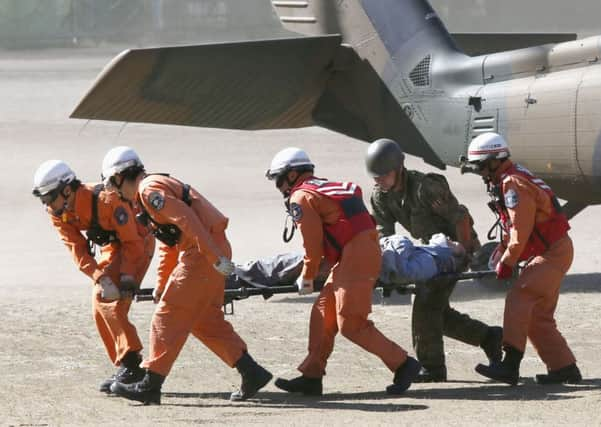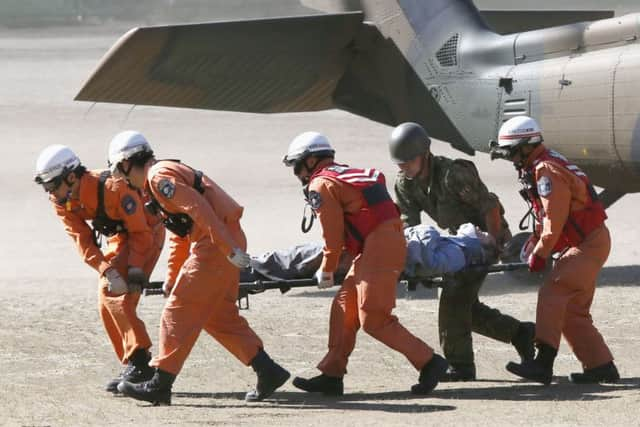Japan: Over 30 believed dead after volcano blast


Mount Ontake, about 130 miles west of Tokyo, erupted shortly before noon on Saturday, sending thick plumes of smoke and rocks into the air.
The walking peak was packed with hikers when it exploded, sending a huge cloud of ash and rock tumbling down its slopes for more than two miles
Advertisement
Hide AdAdvertisement
Hide AdPolice said rescuers had found 31 people suffering from heart and lung failure. Official confirmation that the victims are dead was not expected until doctors have examined the bodies.


About 250 people, including children, were near the 3,067m peak when the eruption came.
Most were able to make their way down the mountain to safety, but some spent the night wrapped in blankets, huddling in the basements of buildings.
An official in the area said rescue efforts had been called off overnight on Saturday due to light conditions and rising levels of toxic gas near the peak.
The Self-Defence Force, the Japanese military, has deployed seven helicopters and 250 troops. Police and fire departments are also taking part in the rescue effort.
“The volcanic rocks fell like hailstones,” one man said. “We couldn’t breathe so we covered our mouths with towels. We couldn’t open our eyes either.”
Heavy, toxic volcanic ash up to 20cm thick covered much of the mountain.
Speaking at the scene, a hiker said: “The roof on the mountain lodge was destroyed by falling rock, so we had to take refuge below the building. That’s how bad it was.”
Advertisement
Hide AdAdvertisement
Hide AdA large plume, a mixture of white and grey, continued to rise from the ash-covered summit of the volcano yesterday morning, visible from the nearby village of Otaki. A convoy of red fire appliances, sirens blaring, and rescue workers on foot headed past barriers into the restricted zone around the mountain.
Shinichi Shimohara, who works at a shrine at the foot of the mountain, was on his way up on Saturday morning when he heard a noise that sounded like strong winds followed by “thunder” as the volcano erupted.
“For a while I heard thunder pounding a number of times,” he said. “Soon after, some climbers started descending. They were all covered with ash, completely white. I thought to myself, this must be really serious.”
Mikio Oguro, a journalist who was on the slope, said he saw a massive amount of smoke coming out of the crater, blocking sunlight and reducing visibility to zero.
“Massive ash suddenly fell and the entire area was totally covered with ash,” he said. He and his crew had to use headlamps to find a lodge. My colleagues later told me that they thought they might die.”
The Fire and Disaster Management Agency yesterday said authorities were trying to confirm the whereabouts of 45 people. It was not clear if this included the 31 people found dead yesterday.
The volcano was still erupting yesterday, pouring smoke and ash hundreds of metres into the sky. Ash was found on cars as far as 50 miles away.
Japan lies on the “Ring of Fire,” a horseshoe-shaped band of fault lines and volcanoes circling the edges of the Pacific Ocean, and is home to 110 active volcanoes.
Advertisement
Hide AdAdvertisement
Hide AdIt is one of the world’s most seismically active nations, but there have been no fatalities since 1991, when 43 people died when a superheated current of gas and rock hit Mount Unzen in southwestern Japan.
Ontake, Japan’s second-highest volcano, 125 miles west of Tokyo, last erupted seven years ago. Its last major eruption was in 1979.
Satoshi Saito, a 52-year-old hiker who climbed Ontake on Saturday and descended less than an hour before the eruption, said the weather was good and the mountain, known for its autumn foilage, was crowded with people carrying cameras.
He said: “There were no earthquakes or strange smells on the mountain when I was there.
“But a man who runs a hotel near the mountain told me that the number of small earthquakes had risen these past two months, and everyone thought it was weird.”
Video footage on the internet showed huge grey clouds boiling towards climbers at the peak and people scrambling to descend as blackness enveloped them.
Windows in a mountain lodge could be seen darkening and people screaming as heavy objects pelted the roof.
Local Shuichi Mukai, who works in a mountain lodge just below the peak, said: “All of a sudden ash piled up so quickly that we couldn’t even open the door. The building quickly filled with hikers taking refuge.
Advertisement
Hide AdAdvertisement
Hide Ad“We were really packed in, maybe 150 people. There were some children crying, but most people were calm.
“We waited there in hard hats until they told us it was safe to come down.”
Flights at Tokyo’s Haneda airport suffered delays on Saturday as planes changed routes to avoid the volcano, which straddles Nagano and Gifu prefectures, but were mostly back to normal yesterday.
An official at the volcano division of the Japan Meteorological Agency said that, while there had been a rising number of small earthquakes detected at Ontake since 10 September, the eruption could not have been predicted easily.
The official said: “There were no other signs of an imminent eruption, such as earth movements or changes on the mountain’s surface.
“With only the earthquakes, we couldn’t really say this would lead to an eruption.”